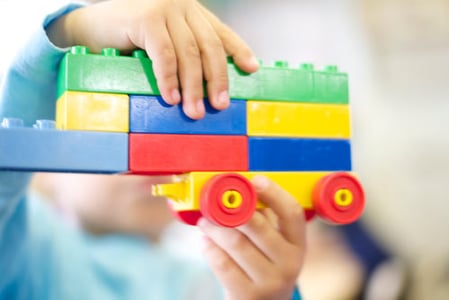
I recently received this question from a CLASS observer:
Where would an observer enter evidence for an interaction between a teacher and children who are fighting? In the interaction, the teacher was using conflict resolution skill-building techniques, but it seems like it could go in more places than Behavior Management.
Good question! Let's take a closer look at this kind of scenario.
Two children, Billy and Bobby, are fighting over a truck in the block area. They are both pulling on the truck and yelling at each other, “MINE!”
The teacher goes over and calms them down, saying, "I will help you, you can find ways to figure out how to play with the truck." She asks, "Is there another truck? No? You both want this one? OK, there's only one truck and both of you want it? Is there a way one of you can have it first and the other one next? Would the timer help? There are several ways you could resolve this, can you think of any?"
The boys take a couple of minutes to decide Billy will get it first. Bobby looks disappointed. The teacher says, "You did a great job figuring out how to resolve this problem. Why did you decide that Billy would go first?" The boys tell her that Billy 'wanted it.'
The teacher presses, "Bobby, are you really OK with the solution? You look disappointed?" Bobby holds his head down. The teacher says, "Billy, I don't think Bobby is ready to go back to work yet. He isn't OK with this solution. Is there a way you can help?"
She facilitates more discussion. The boys decide that Billy will get the truck first, and Bobby will have the timer. They both seem OK with this and anxious to get back to their play.
Keep in mind, in this type of scenario an observer would try to capture as much as possible before the next interaction, but they likely wouldn't have time to record all outcomes. And that's okay! Depending on the scenario, however, some dimensions would be better to sort evidence into than others.
Here are some possible places to put evidence of this rich interaction:
Positive Climate
- Respect: Cooperation and sharing—The boys worked out a cooperative solution.
Negative Climate
- Negative Affect: Peer aggression—Consider if this is an isolated incident, how long it lasted, and how much it disrupted other children. (A skilled observer would be timing the duration of the negative, argumentative portion of the conflict).
Teacher Sensitivity
- Awareness: The teacher was aware of the scuffle and went over to help.
- Responsiveness: The teacher responded immediately, calming them and providing comfort and assistance, acknowledging the emotion "disappointed."
- Addresses Problems: The teacher helped the boys resolve the problem effectively (the boys were both satisfied with the final outcome).
Regard for Student Perspectives
- Support for Autonomy and Leadership: The teacher helped, but the boys were expected to work on this resolution between each other.
Behavior Management
- Clear Behavior Expectations: The teacher made it clear that it is not OK to fight and yell.
- Being proactive: She helped the children to resolve conflicts before they escalated.
- Effective Redirection of Misbehavior: The teacher successfully redirected the fight to a productive conversation and back to an activity.
- Student Behavior: The children were compliant when they agreed to talk about who gets the toy next.
Instructional Learning Formats
- Effective Facilitation: The teacher displayed teacher involvement, effective questioning, and expanding children's involvement (through problem-solving dialogue).
Concept Development
- Analysis and Reasoning: Problem solving—The boys needed to think and come up with a creative solution of their own ideas to solve this dilemma.
- Brainstorming: The teacher asked the children to brainstorm (There are several ways you could decide to resolve this, can you think of any?").
Quality of Feedback
- Scaffolding: The teacher provided hints and assistance ("Would a timer help? Is there a way one of you can have it first and the other next?").
- Feedback Loop: The teacher had a sustained back-and-forth exchange with each boy regarding the problem, and they all show persistence.
- Prompting Thought Processes: The teacher asked, "Why did you decide that Billy got the truck first?"
- Encouragement and Affirmation: The teacher provided affirmation ("You did a great job figuring this out together") and went on to help them persist and continue.
Language Modeling
- Frequent Conversation: It took a lot of dialogue and back and forth exchanges from the boys to resolve this.
- Open-Ended Questions: "Well, what are we going to do about that? Is there a way you can help?"
- Repetition and Extension: "You both say you, 'want this truck.'"
